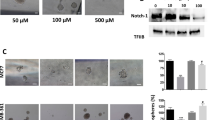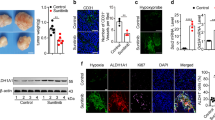Abstract
Tumor hypoxia is associated with cancer invasiveness, metastasis and treatment failure. Recent data suggest that the major target for endocrine treatment in breast cancer, ERα, is downregulated during hypoxia, but the mechanism behind this remains unknown. MAPK signaling as well as ERα regulation has earlier been independently linked to hypoxia and we now demonstrate HIF-1α and ERK1/2-activation in vivo towards the necrotic zone in DCIS of the breast, parallel with ERα downregulation. Hypoxia further caused transcriptional downregulation of ERα via activation of ERK1/2 in cell lines and, importantly, MEK1/2 inhibitors (U0126 or PD184352) or ERK1/2 suppression by siRNA partially restored the ERα expression. U0126 combined with tamoxifen accordingly produced an increased efficacy of the anti-estrogens during hypoxia. Based on these findings, we suggest a promising novel therapy for ERα-positive breast cancer where a combination of endocrine treatment and ERK1/2 inhibitors may increase treatment response by improved targeting of dormant hypoxic tumor cells.
This is a preview of subscription content, access via your institution
Access options
Subscribe to this journal
Receive 50 print issues and online access
$259.00 per year
only $5.18 per issue
Buy this article
- Purchase on Springer Link
- Instant access to full article PDF
Prices may be subject to local taxes which are calculated during checkout



Similar content being viewed by others
References
Ali S and Coombes RC . (2002). Nat. Rev. Cancer, 2, 101–112.
Bhat-Nakshatri P, Campbell RA, Patel NM, Newton TR, King AJ, Marshall MS, Ali S and Nakshatri H . (2004). Br. J. Cancer, 90, 853–859.
Brunnberg S, Pettersson K, Rydin E, Matthews J, Hanberg A and Pongratz I . (2003). Proc. Natl. Acad. Sci. USA, 100, 6517–6522.
Chen D, Washbrook E, Sarwar N, Bates GJ, Pace PE, Thirunuvakkarasu V, Taylor J, Epstein RJ, Fuller-Pace FV, Egly JM, Coombes RC and Ali S . (2002). Oncogene, 21, 4921–4931.
Cho J, Kim D, Lee S and Lee Y . (2005). Mol. Endocrinol., 19, 1191–1199.
Cooper C, Liu GY, Niu YL, Santos S, Murphy LC and Watson PH . (2004). Clin. Cancer Res., 10, 8720–8727.
Coutts AS and Murphy LC . (1998). Cancer Res., 58, 4071–4074.
Dokladda K, Green KA, Pan DA and Hardie DG . (2005). FEBS Lett., 579, 236–240.
Duncia JV, Santella III JB, Higley CA, Pitts WJ, Wityak J, Frietze WE, Rankin FW, Sun JH, Earl RA, Tabaka AC, Teleha CA, Blom KF, Favata MF, Manos EJ, Daulerio AJ, Stradley DA, Horiuchi K, Copeland RA, Scherle PA, Trzaskos JM, Magolda RL, Trainor GL, Wexler RR, Hobbs FW and Olson RE . (1998). Bioorg. Med. Chem. Lett., 8, 2839–2844.
EBCTCG (1998). Lancet, 351, 1451–1467.
Gee JM, Harper ME, Hutcheson IR, Madden TA, Barrow D, Knowlden JM, McClelland RA, Jordan N, Wakeling AE and Nicholson RI . (2003). Endocrinology, 144, 5105–5117.
Gee JM, Robertson JF, Ellis IO and Nicholson RI . (2001). Int. J. Cancer, 95, 247–254.
Harris AL . (2002). Nat. Rev. Cancer, 2, 38–47.
Harrison JS, Rameshwar P, Chang V and Bandari P . (2002). Blood, 99, 394.
Hedenfalk I, Glarner N, Kronblad A, Veerla S, Ringnér M and Landberg G . (2005). Cancer Genom. Proteom., 2, 83–96.
Helczynska K, Kronblad A, Jogi A, Nilsson E, Beckman S, Landberg G and Pahlman S . (2003). Cancer Res., 63, 1441–1444.
Holloway JN, Murthy S and El-Ashry D . (2004). Mol. Endocrinol., 18, 1396–1410.
Hutcheson IR, Knowlden JM, Madden TA, Barrow D, Gee JM, Wakeling AE and Nicholson RI . (2003). Breast Cancer Res. Treat., 81, 81–93.
Jogi A, Vallon-Christersson J, Holmquist L, Axelson H, Borg A and Pahlman S . (2004). Exp Cell Res., 295, 469–487.
Johnson GL and Lapadat R . (2002). Science, 298, 1911–1912.
Johnston SR and Dowsett M . (2003). Nat. Rev. Cancer, 3, 821–831.
Kronblad A, Helczynska K, Nielsen NH, Pahlman E, Emdin S, Pahlman S and Landberg G . (2003). In vivo, 17, 311–318.
Kurebayashi J, Otsuki T, Moriya T and Sonoo H . (2001). Jpn. J. Cancer Res., 92, 1093–1101.
Kuukasjarvi T, Kononen J, Helin H, Holli K and Isola J . (1996). J. Clin. Oncol., 14, 2584–2589.
Lichtman MA . (1981). Exp. Hematol., 9, 391–410.
Minet E, Arnould T, Michel G, Roland I, Mottet D, Raes M, Remacle J and Michiels C . (2000). FEBS Lett., 468, 53–58.
Nicholson RI, Hutcheson IR, Knowlden JM, Jones HE, Harper ME, Jordan N, Hiscox SE, Barrow D and Gee JM . (2004). Clin. Cancer Res., 10, 346S–354S.
Oh AS, Lorant LA, Holloway JN, Miller DL, Kern FG and El-Ashry D . (2001). Mol. Endocrinol., 15, 1344–1359.
Rostagno P, Caldani C and Lahlou B . (1996). Breast Cancer Res. Treat, 37, 77–87.
Semenza GL . (2003). Nat. Rev. Cancer, 3, 721–732.
Shawver LK, Slamon D and Ullrich A . (2002). Cancer Cell, 1, 117–123.
Shim WS, Conaway M, Masamura S, Yue W, Wang JP, Kmar R and Santen RJ . (2000). Endocrinology, 141, 396–405.
Sivaraman VS, Wang H, Nuovo GJ and Malbon CC . (1997). J. Clin. Invest., 99, 1478–1483.
Spataro V, Price K, Goldhirsch A, Cavalli F, Simoncini E, Castiglione M, Rudenstam CM, Collins J, Lindtner J and Gelber RD . (1992). Ann. Oncol., 3, 733–740.
Stoner M, Saville B, Wormke M, Dean D, Burghardt R and Safe S . (2002). Mol. Endocrinol., 16, 2231–2242.
Vandesompele J, De Paepe A and Speleman F . (2002a). Anal. Biochem., 303, 95–98.
Vandesompele J, De Preter K, Pattyn F, Poppe B, Van Roy N, De Paepe A and Speleman F . (2002b). Genome Biol., 3, 1–12.
Vaupel P, Kallinowski F and Okunieff P . (1989). Cancer Res., 49, 6449–6465.
Woelfle U, Cloos J, Sauter G, Riethdorf L, Janicke F, van Diest P, Brakenhoff R and Pantel K . (2003). Cancer Res., 63, 5679–5684.
Yang Z, Barnes CJ and Kumar R . (2004). Clin. Cancer Res., 10, 3621–3628.
Acknowledgements
This study was supported by grants from the Swedish Cancer Society, Gunnar, Arvid and Elisabeth Nilsson Cancer Foundation, Lund University Research Funds, Per-Erich and Ulla Schybergs Foundation, Malmö University Hospital Research and Cancer Funds and Swegene/Wallenberg Consortium North. IH was supported by a postdoctoral fellowship from the K & A Wallenberg Foundation through the Swegene Consortium.
Author information
Authors and Affiliations
Corresponding author
Rights and permissions
About this article
Cite this article
Kronblad, Å., Hedenfalk, I., Nilsson, E. et al. ERK1/2 inhibition increases antiestrogen treatment efficacy by interfering with hypoxia-induced downregulation of ERα: a combination therapy potentially targeting hypoxic and dormant tumor cells. Oncogene 24, 6835–6841 (2005). https://doi.org/10.1038/sj.onc.1208830
Received:
Revised:
Accepted:
Published:
Issue Date:
DOI: https://doi.org/10.1038/sj.onc.1208830
Keywords
This article is cited by
-
The role of mitochondrial/metabolic axis in development of tamoxifen resistance in breast cancer
Human Cell (2023)
-
Metabolic/hypoxial axis predicts tamoxifen resistance in breast cancer
Scientific Reports (2022)
-
Comparison of protein expression between formalin-fixed core-cut biopsies and surgical excision specimens using a novel multiplex approach
Breast Cancer Research and Treatment (2019)
-
Genome-independent hypoxic repression of estrogen receptor alpha in breast cancer cells
BMC Cancer (2017)
-
Associations of proteins relevant to MAPK signaling pathway (p38MAPK-1,HIF-1 and HO-1) with coronary lesion characteristics and prognosis of peri-menopausal women
Lipids in Health and Disease (2016)



